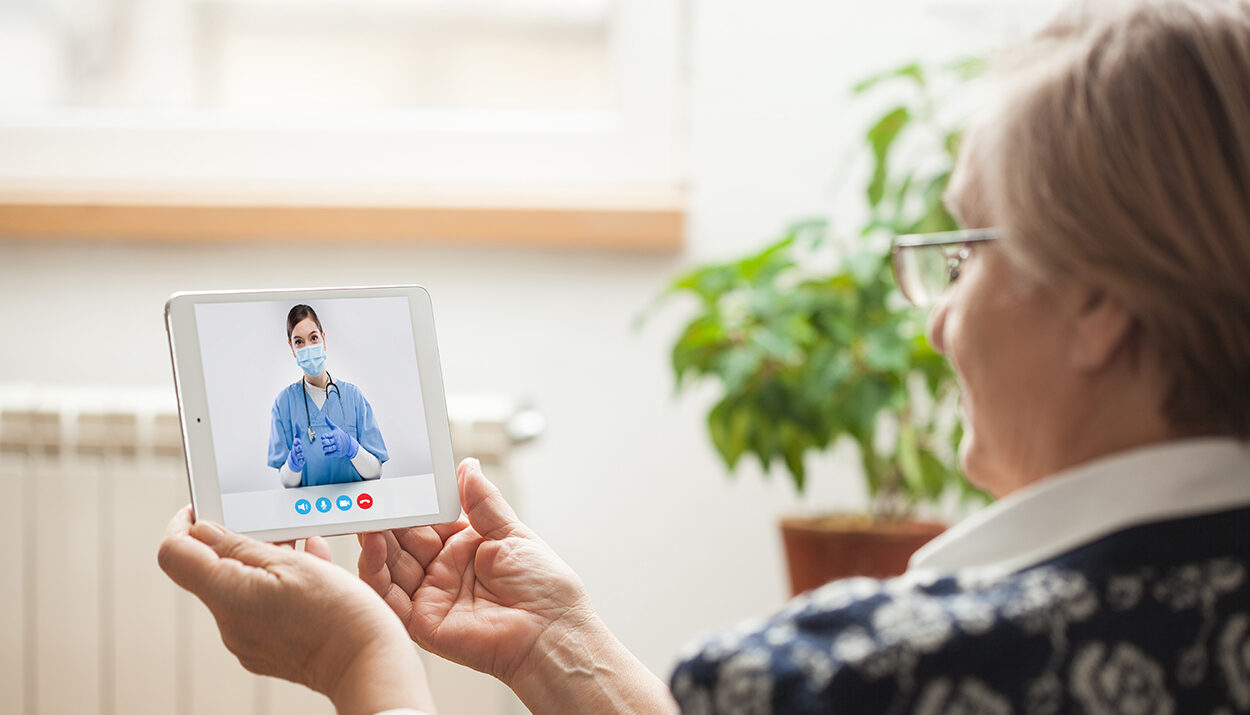The COVID-19 pandemic was a seismic event that forced healthcare into a digital revolution. Overnight, telehealth went from a niche service to a necessity. In April 2020, in-person medical visits decreased by 52% while telehealth visits leapt by 4000%, according to a study in the JAMA Network Open. Doctors and nurses were adapting to it and patients loved it.
The outcome? We now see that virtual care is here to stay.
At the heart of this shift is telehealth nursing. This is an intactly unique model that brings together technology and compassionate care. Nurses now monitor chronic conditions via wearables. They conduct post-op follow-ups through video and triage patients remotely. But one question arises – is this just a crisis-driven trend? Or is telehealth nursing the future of patient care and here to stay?
The answer lies in its growing adoption and the undeniable benefits of accessibility. Let us explore how telehealth nursing is taking the world by storm. And whether it’s the next evolution in nursing.
Continue reading to know more!
Telehealth Nursing – The Basic Gist
It refers to the delivery of nursing care and services remotely through telecommunications technologies. It is not like traditional bedside nursing. Instead, it relies on:
- Video consultations
- Remote patient monitoring
- Chronic disease coaching
- Triage and 24/7 support
Telehealth nursing relies heavily on technology. However, its impact is equally profound. It leverages tools like electronic health records, wearable devices that track vitals and mobile health apps. Telehealth nurses can provide timely and effective care to patients who might otherwise face barriers to access it.
There are many benefits of telehealth nursing. But its most important aspect is enabling greater access to care. Whether there are few facilities nearby or someone has trouble traveling to a clinic, telehealth can help all kinds of people get the medical care they need.
Is it as effective as in-person care? Studies say yes and for the right reasons! A report by the National Institute of Health said that 54.1% used telehealth as an effective tool for cancer support before and after treatment. The key? It is not replacing hands-on care. Rather, it is enhancing the efficacy of such care.
Telehealth Nursing – A Brief History and Way Forward
The roots of telehealth nursing can be traced back to the mid-twentieth century. It was initially used in limited capacities. But soon, telehealth nursing gained prominence. This was especially true during the recent global health crisis. This was a time when telehealth nursing became a means to provide efficient and accessible healthcare services.
A McKinsey consumer research found that many people who were surveyed view telehealth favourably. About 40% said they plan to use these services for future healthcare needs. This number was just 11% prior to the pandemic. It marks a radical shift in the way people view the value proposition of telehealth nursing.
Why Telehealth Nursing Is Gaining Phenomenal Momentum?

There are several factors that have contributed to the growing prominence of telehealth nursing. Here we are talking about a few:
1. Demand for accessible care
An aging population and the rise in chronic illnesses have placed immense pressure on healthcare systems. Telehealth offers a scalable solution by bringing care directly to patients’ homes.
2. Cost-effectiveness
Remote care reduces costs for patients and healthcare providers. It does so by minimizing hospital admissions and travel expenses.
3. Rural healthcare access
Telehealth bridges the gap for patients in remote or underserved areas. This is especially true for those who struggle to access in-person care.
4. Flexibility and convenience
Telehealth offers flexibility to patients and nurses. Nurses can manage more patients without geographical constraints. On the other hand, patients benefit from faster triage and reduced wait times.
These factors make telehealth nursing not just a convenience. Instead, it’s a necessity in modern healthcare systems. According to a report by the American Academy of Dermatology, 75% of dermatologists used telemedicine in 2020. This is in comparison to 2019 when it was just 2%. The momentum of telehealth nursing is undeniable.
A Glimpse into the Roles Taken up by Telehealth Nurses
Telehealth nursing has evolved from simply answering questions about medications or discussing symptoms over calls/video calls. Now it has become an integral part of healthcare management for many patients.
Nurses working in this capacity can develop strong connections with patients. This allows them to develop a better perspective on how a patient’s treatment is going on, and what problems they are facing. Access to such information can help the physician and their healthcare team provide better care.
Technology-based consultations provide the opportunity to interact with patients who have barriers to coming to the physician’s office or live in remote areas.
Tele nurses can serve as health coaches for people who wish to improve their health or are recovering from life-altering medical situations. Telehealth nurses also coordinate care for patients who have to see multiple physicians for several conditions.
For people learning to cope with new illnesses or recovering from medical procedures, tele nurses can serve as educators. Another advantage is they can provide round the clock assistance for medical queries or emergencies.
In most cases, these efforts can be done with fewer staff and at a lower cost.
Challenges Faced by Nurses in Telehealth
Despite the various advantages of telehealth nursing, there are still some problems associated with it. As with any new technology, adoption can be difficult for both nurses and patients. This is because they are used to doing things a certain way.
Effective training programs, user-friendly platforms and support for new users can help ease the transition to telehealth to make it smoother than ever.
Like all technologies that deal with sensitive user information, there are also numerous legal, ethical and regulatory concerns associated with providing medical care remotely. Healthcare facilities and their employees should be vigilant about protecting patient data. They should adhere to both state and federal laws.
As telehealth continues to grow in popularity, it is also important to consider its effect on patient-provider relationships. Virtual appointments are great for all parties involved. But they also create obstacles with nonverbal communication and clues. These are both things nurses use to provide effective care.
Striking a balance between accessibility and hands on care is very important as telehealth becomes more commonplace.
Training and Upskilling for Telehealth Nurses
Telehealth nursing is not just about nursing over a Zoom call. It requires new skills that nurses have to develop. They need to have digital empathy where they can convey warmth and care for patients through laptop/desktop/tablet screens.
Nurses need to be digitally literate so that they can operate various devices. They also need to be aware of cybersecurity and protect patient privacy.
In order to become capable of caring for patients remotely, nurses can turn to Telehealth Professional Development. It addresses a range of relevant topics that help them be more impactful at their work in telehealth.
Online education is another interesting aspect worth exploring. It can help nurses prepare for their remote work by exercising their communication skills in virtual situations. It may also give them a chance to develop a greater understanding of some of the communication pitfalls.
Here are some sources that provide learning opportunities that cover telehealth concepts and technology:
- National Telehealth Technology Assessment Resource Centre
- ANA Continuing Education
- CORE Concepts in Telehealth Certificate Program
- The National Consortium of Telehealth Resource Centres
Universities and healthcare institutions are increasingly incorporating telehealth modules into their curricula. This is to prepare nurses for these evolving demands.
Patient Response and Outcomes So Far
Telehealth nursing is not just a convenient option. It is proving to be just as effective. The data surrounding it speaks for itself.
A search undertaken in April 2022 revealed that nurse-led telehealth has improved access to care. Patients who go for remote healthcare have high levels of satisfaction. Patients’ travel time and cost is saved and service providers miss fewer appointments. Over 80% of people prefer telemedicine services over traditional in clinic visits.
Many diabetes management studies showed that telemedicine interventions integrated into structured programs improved HbA1c levels. Similarly, heart failure patients in another study reported fewer readmissions with telehealth nurse check-ins.
Telehealth nurses help to streamline and automate procedures, freeing up time for more complex clinical tasks. This can significantly increase efficiency and improve patient outcomes.
The Future Outlook: The Trend is Fast Moving Towards a Hybrid Care Model
Telehealth nursing will not replace hospitals. In fact, it will reshape them. Here is what you can expect:
1. Blended care models
Patients may alternate between virtual consultations and physical visits based on their needs.
2. AI integration
Artificial intelligence could assist nurses. It can do so by analyzing patient data from wearables or predicting health risks.
3. Remote diagnostic tools
Growth in technology will enable more accurate assessments during virtual consultations.
Telehealth is here to stay and will continue to grow in popularity. Telehealth nurses will play a big role in ensuring telehealth programs’ success. There may be resistance and roadblocks to adopting new technology at first. But understanding its impact on patients as well as its role in reducing nurse burnout can help in embracing the technology.
The bottom line? The future is not virtual vs. in person- it’s both.
Telehealth Nursing – A Necessity in the Digital World

Telehealth nursing is not a pandemic fluke. It has emerged to be the future of patient care. With the right tech, regulations and training, this field can expand and save lives.
As one nurse put it: “The future of care doesn’t have to be in a hospital. Sometimes, it’s just a screen away with a nurse, who still cares just as much.”
As a nurse or healthcare expert, you can voice your opinion on this matter. Explore the quick surveys on MDForLives and share your opinions. We have a large community of Allied healthcare professionals. Join us, take surveys, and receive an honorarium as a token of appreciation for your valuable contributions.
FAQs
-
What is the meaning of telehealth nursing?
It refers to remote nursing care using technology. It is future centered care. Nurses monitor, assess and guide patients through video calls, messaging, healthcare apps and wearables. All this can be done without being in the same room.
-
What skills are most important for a telehealth nurse?
A good telehealth nurse needs-
– Tech skills
– Strong communication
– Critical thinking
– Time management
-
What is the definition of telehealth?
Telehealth is healthcare delivered digitally. It can be done via video calls, phone consultations, remote apps and devices. It includes doctor visits, nursing care, therapy and even AI-assisted diagnostics.
-
What is tele in nursing?
“Tele” means distance (from Greek). In nursing, it refers to remote care—using technology to help patients without traditional clinic visits. Examples:
– A nurse checking a diabetic patient’s glucose readings via an app.
-A video call teaching a new mom how to care for her baby.
References:
- https://www.ebsco.com/research-starters/nursing-and-allied-health/telehealth-nursing
- https://www.healthrecoverysolutions.com/blog/telehealth-nursing-explained

MDForLives is a vibrant community of healthcare professionals and patients dedicated to shaping the future of healthcare. We provide valuable global insights to healthcare companies through online surveys, interviews, and discussion forums.






